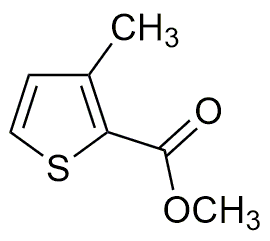Methyl 3-methylthiophene-2-carboxylate is widely utilized in research focused on:
- Flavor and Fragrance Industry: This compound serves as a key ingredient in creating unique flavor profiles and fragrances, enhancing products like perfumes and food additives.
- Pharmaceutical Development: It is used in the synthesis of various pharmaceutical intermediates, contributing to the development of new medications with improved efficacy.
- Agricultural Chemicals: The compound can be employed in formulating agrochemicals, including pesticides and herbicides, aimed at improving crop yield and protection.
- Material Science: It finds applications in developing advanced materials, particularly in creating polymers and coatings with desirable properties.
- Research and Development: This chemical is valuable in academic and industrial research settings for studying thiophene derivatives and their applications in organic electronics.
General Information
Properties
Safety and Regulations
Applications
Methyl 3-methylthiophene-2-carboxylate is widely utilized in research focused on:
- Flavor and Fragrance Industry: This compound serves as a key ingredient in creating unique flavor profiles and fragrances, enhancing products like perfumes and food additives.
- Pharmaceutical Development: It is used in the synthesis of various pharmaceutical intermediates, contributing to the development of new medications with improved efficacy.
- Agricultural Chemicals: The compound can be employed in formulating agrochemicals, including pesticides and herbicides, aimed at improving crop yield and protection.
- Material Science: It finds applications in developing advanced materials, particularly in creating polymers and coatings with desirable properties.
- Research and Development: This chemical is valuable in academic and industrial research settings for studying thiophene derivatives and their applications in organic electronics.
Documents
Safety Data Sheets (SDS)
The SDS provides comprehensive safety information on handling, storage, and disposal of the product.
Product Specification (PS)
The PS provides a comprehensive breakdown of the product’s properties, including chemical composition, physical state, purity, and storage requirements. It also details acceptable quality ranges and the product's intended applications.
Certificates of Analysis (COA)
Search for Certificates of Analysis (COA) by entering the products Lot Number. Lot and Batch Numbers can be found on a product’s label following the words ‘Lot’ or ‘Batch’.
*Catalog Number
*Lot Number
Certificates Of Origin (COO)
This COO confirms the country where the product was manufactured, and also details the materials and components used in it and whether it is derived from natural, synthetic, or other specific sources. This certificate may be required for customs, trade, and regulatory compliance.
*Catalog Number
*Lot Number
Safety Data Sheets (SDS)
The SDS provides comprehensive safety information on handling, storage, and disposal of the product.
DownloadProduct Specification (PS)
The PS provides a comprehensive breakdown of the product’s properties, including chemical composition, physical state, purity, and storage requirements. It also details acceptable quality ranges and the product's intended applications.
DownloadCertificates of Analysis (COA)
Search for Certificates of Analysis (COA) by entering the products Lot Number. Lot and Batch Numbers can be found on a product’s label following the words ‘Lot’ or ‘Batch’.
*Catalog Number
*Lot Number
Certificates Of Origin (COO)
This COO confirms the country where the product was manufactured, and also details the materials and components used in it and whether it is derived from natural, synthetic, or other specific sources. This certificate may be required for customs, trade, and regulatory compliance.


